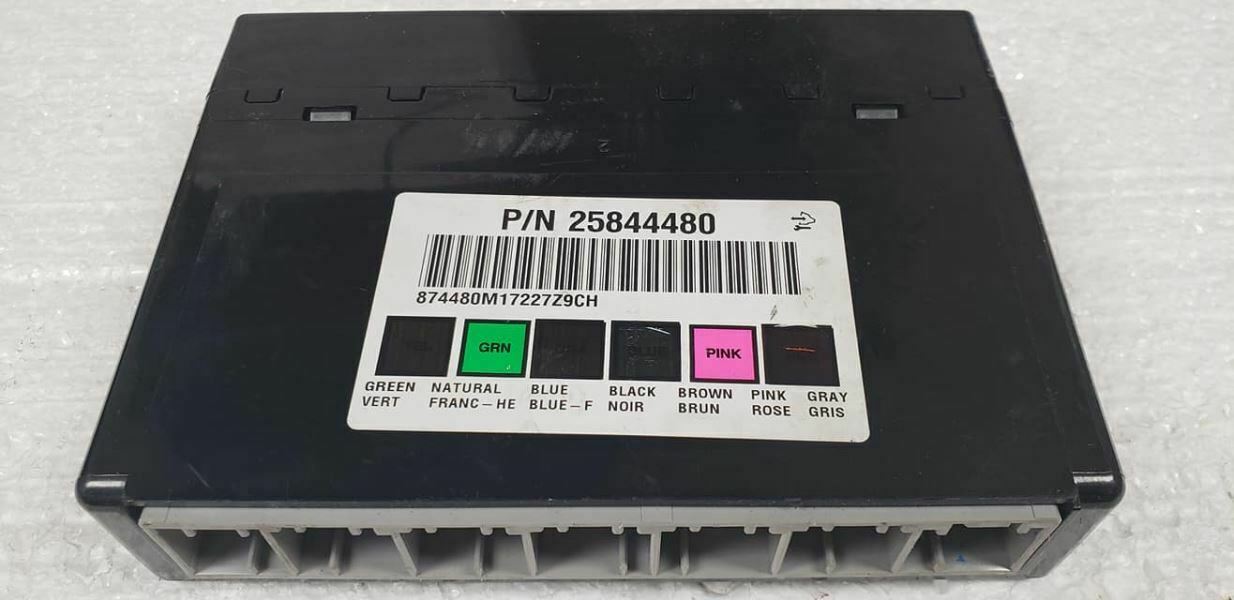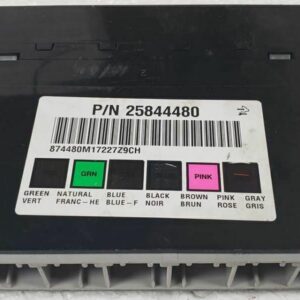Tired of Chasing Electrical Gremlins in Your GM Truck?
If you’re dealing with a 2013 Sierra Denali 2500 that seems to have a mind of its own—with flickering lights, a dead HVAC system, or power windows that won’t budge—you’ve likely met the frustrating symptoms of a failing Body Control Module (BCM). As the central command for your vehicle’s body electronics, a faulty BCM can cause a cascade of baffling issues that are difficult to diagnose. This isn’t just an annoyance; it can affect your truck’s security and safety. This VIN-programmed Body Control Module, a direct replacement for part numbers like 25790508 and 25844480, is the definitive solution to restore order and reliability to your vehicle.
We take the guesswork and dealer expense out of the equation. By providing your vehicle’s VIN during checkout, we program the module with the latest GM software specific to your truck. This means it arrives at your door ready for a true plug-and-play installation, eliminating the need for expensive scan tools or a trip to the dealership. Solve those persistent electrical problems for good and get your truck operating exactly as it should.
From the Diagnostic Bay: The Case of the Haunted Sierra
I once had a 2011 Sierra 2500 in my bay that was driving the owner crazy. The radio would turn on and off, the driver’s side window worked intermittently, and the security light would flash, sometimes preventing it from starting. The owner had already replaced the battery and checked fuses. After hooking up my scanner, I saw a dozen communication codes pointing in different directions. This is a classic sign of a failing BCM. In my 20+ years, I’ve seen hundreds of these GMT900 platform trucks where a failing BCM acts like a network jammer, causing chaos. We installed a VIN-programmed module, and every single issue vanished instantly. It’s a reminder that sometimes the most complex-seeming problems have a single, straightforward solution.
Is Your GM Truck or SUV Showing These Signs?
A failing BCM doesn’t always trigger a check engine light. Instead, it manifests as a collection of strange electrical failures. Here are the most common symptoms I see in the shop:
- ✔ Power windows, door locks, or mirrors stop working or behave erratically.
- ✔ The HVAC system is unresponsive, or the blower motor cuts in and out.
- ✔ An airbag warning light is illuminated, often with a DTC B1001 (Setup SDM Primary Key in BCM).
- ✔ The security system malfunctions, leading to no-start or stalling conditions.
- ✔ Interior dome lights or exterior lights (headlights, taillights) fail to operate correctly.
- ✔ The windshield wipers won’t turn on, or they won’t turn off.
- ✔ Communication errors with other modules, resulting in a variety of DTCs.
A Straightforward Guide to Installation
One of the best parts about this solution is its simplicity. For most DIYers and professional techs, this is a job that takes less than 10 minutes. The BCM is typically located under the driver’s side dashboard, near the steering column.
- Safety First: Always disconnect the negative terminal from your vehicle’s battery before working on any electronic components.
- Locate the BCM: On most GM trucks and SUVs, it’s a black box with multiple large connectors, mounted to a bracket under the dash, to the left of the steering column.
- Disconnect and Remove: Carefully unplug the electrical connectors. They have locking tabs that need to be depressed. Once disconnected, unclip or unbolt the old module from its mounting location.
- Install the New Module: Seat the new, pre-programmed BCM into the mounting bracket and securely plug in all the electrical connectors. You’ll hear a click as they lock into place.
- Reconnect and Test: Reconnect the negative battery terminal. Turn the key to the ‘ON’ position and test all functions: windows, locks, lights, wipers, and the HVAC system.
- Post-Install Check: In some cases, particularly if you had a DTC B1001, the airbag light may remain on. This requires a ‘Setup SDM Primary Key’ relearn procedure using a bi-directional scan tool. Similarly, a Brake Pedal Position relearn may be needed.
Will This Fit My Truck?
This module is engineered for a wide range of General Motors trucks and SUVs from 2007-2013, providing a reliable fix for many popular models. It is a direct replacement for part numbers 25790508, 25844480, 25835966, and many others. Please verify your vehicle is on the list below.
Escalade (2007-2011), Escalade ESV (2007-2011), Escalade EXT (2007-2011)
Chevrolet:
Avalanche 1500 (2007-2011), Silverado 1500 (2007-2011), Silverado 2500 (2007-2013), Silverado 3500 (2007-2013), Suburban 1500 (2007-2011), Suburban 2500 (2007-2011), Tahoe (2007-2011)
GMC:
Sierra 1500 (2007-2011), Sierra 2500 (2007-2013), Sierra 3500 (2007-2013), Sierra Denali (2007-2010), Sierra Denali 1500 (2011), Sierra Denali 2500 (2011-2013), Sierra Denali 3500 (2011-2013), Yukon (2007-2011), Yukon XL 1500 (2007-2011), Yukon XL 2500 (2007-2011)
Frequently Asked Questions
Is this BCM difficult to install?
Not at all. The physical installation takes just a few minutes with basic hand tools. Because we program it to your VIN, you avoid the complex and costly programming steps required at a dealership.
Do I need to send my old BCM back?
No, there is no core charge for this part. You can keep your old module, which saves you the time and hassle of return shipping.
What does ‘VIN Programmed’ actually mean?
It means we load the module with your vehicle’s specific software and configuration based on its Vehicle Identification Number (VIN). This ensures all the electronic features your truck was built with will work correctly right out of the box.
My airbag light is on. Will this fix it?
This module will often resolve the root cause of an airbag light related to BCM failure (like DTC B1001). However, after installation, you may need a professional scan tool to perform the ‘Setup SDM Primary Key in BCM’ procedure to clear the light.
What if I install it and some problems remain?
While this BCM fixes the vast majority of related electrical issues, it’s always wise to check for underlying problems. In my experience, poor ground connections are a common secondary issue on these trucks. Always check the main body and frame grounds for corrosion or looseness during your repair.



